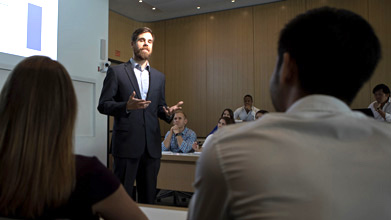January 11, 2018
“Mind-plus-machine partnership” — a past CBC Scholar, Adam Pah, NU, encourages keeping up with the progress in machine learning and artificial intelligence
Adam Pah, clinical assistant professor of management and organizations, teaches an MBA course on Human-Machine Intelligence at the NU Kellogg School of Management. As a part of the Kellogg Architectures of Collaboration Initiative, the course is intended for the ever-growing cadre of MBA students who would employ machine learning in their future endeavors. Adam was a CBC Scholar, Class of 2011. He received his PhD in 2013 from the NU Department of Chemical and Biological Engineering, while working in Luis Amaral’s lab. Congratulations on a successful career!
Kellogg prepares students for impact of human-machine intelligence
Through cutting-edge research, teaching and partnerships, Kellogg prepares students to lead through tech innovation
Northwestern Kellogg News and Views, | by Peter Jurmu | January 5, 2018

Adam Pah’s Human-Machine Intelligence course encourages students to confront important questions and prepare students pursuing careers that involve machine learning.
Photo © Kellogg School
News about technological developments is often accompanied by broad, buzz-worthy statements. Among the favorites of Adam Pah, clinical assistant professor of management and organizations at the Kellogg School of Management, is from software entrepreneur and investor Marc Andreeson, published in The Wall Street Journal in August 2011: “Software is eating the world.”
Andreeson was describing the way that societies are moving from hardware-based systems of commerce to software-based systems. For 2017, Pah believes the more apt version of the axiom is that “Artificial intelligence and machine learning are eating software.”
Because of the shifting data science landscape, Pah’s Human-Machine Intelligence (HMI) course is a key part of the Kellogg Architectures of Collaboration Initiative (KACI), and crucial for any current or prospective MBA student pursuing a career that involves leveraging machine learning, a career type that is ever-widening.
“It’s not a question of how much artificial intelligence and human-machine intelligence will penetrate,” Pah said, “but rather, will anyone still be able to hold on without using AI/HMI, in a competitive market area?”
Exactly how machine learning is changing business at the moment depends on the organization in question, Pah said, but generally companies are using it in similar ways, and using it extensively. Machine learning – the process by which machines use algorithms to identify patterns in data sets and make predictions based on those patterns, without needing to be programmed to do so – is a major time saver for large companies.
“Machine learning is allowing better insights to be mined from data that organizations already own or have access to, which means they can be more productive with their time,” Pah said, “and focus more on the human relationship element that is vital to making everything run smoothly.”
Pah’s Human-Machine Intelligence course encourages students to confront important questions: “How do people fit into this evolving space? What do our interactions look like? How do we manage this process when introducing machine learning? How do we maintain vision around AI/HMI and what it can do?”
These questions are answerable only through engagement and experimentation. Through Kellogg’s emphasis on teamwork and community problem-solving, a heritage that goes back to the 1970s, Pah believes Kellogg offers students an experience no other school can.
Brian Uzzi, Richard L. Thomas Professor of Leadership and Organizational Change and faculty director of the Kellogg Architectures of Collaboration Initiative (KACI), shares this view.
KACI’s human-machine intelligence focus, Uzzi said, enables faculty to prepare students to address the three things machine learning can do for business:
First, it can help people overcome previously unsolvable human biases in decision-making. Second, it can help extend human consciousness, or increase and improve awareness of tasks, themselves and other people. And third, it enables significant increases in the scaling of human effort. Together, those three things make up what Uzzi calls the “mind-plus-machine partnership.”
This partnership, rather than being a complete reworking of past relationships among collaborators, is based on the same model, albeit a turbo-charged one. “The way we’ve always tried to overcome our limitations as individuals is through collaboration with other people,” he said. “And we’re going to continue to do that, but now we have this new entity we can include in that collaboration.”
Source:
Adapted (with modifications) from Northwestern Kellogg News and Views, by Peter Jurmu, posted on January 5, 2018.
See also:
CBC Awards:
CBC Scholar Award (2011-2012):
Adam Pah, Class of 2011
Department of Chemical and Biological Engineering, NU; Advisor: Luis Amaral
▸ Adam’s CBC Scholar Webpage
